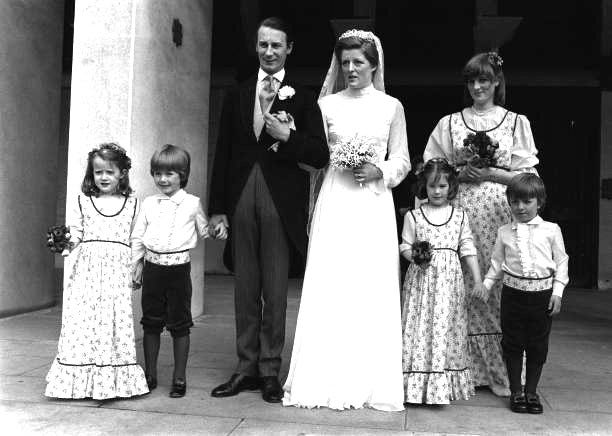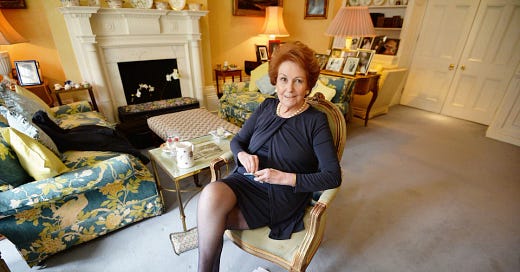An Insider's View of the Royal Family
Part One of a three-part series: The late Lady Elizabeth Anson, Queen Elizabeth II's cousin and confidante, recounted the anguish of Charles and Diana's ill-fated marriage
It is the “season” in England, a time of rituals, celebrations and parades reflecting traditions stretching back hundreds of years: Trooping the Colour, the Order of the Garter procession and service at St. George’s Chapel in Windsor Castle, Buckingham Palace garden parties, and the races at Royal Ascot. When I think of the season, the royal family obviously springs to mind. But I mainly think of one member of the extended network of royal relatives whom I counted as a friend from 1998 until her death at age seventy-nine on November 1, 2020. She was Lady Elizabeth Anson, known for sixty years as the paragon of party planners who organized memorable gatherings for Queen Elizabeth II and other royals as well as celebrities including Mick Jagger and Sting.
“The Number One Lady”
After Lady Elizabeth and I had known each other for several years she said, “Call me ‘Liza.’ It’s softer. In business they call me ‘Liz’”. So, for me it was “Liza” from that moment, a familiarity that was a gesture of trust and friendship from someone who came from the topmost rung of British aristocracy. Her great-aunt was Queen Elizabeth the Queen Mother, her godfather was Queen Elizabeth’s husband, King George VI, and their daughters, Queen Elizabeth II and Princess Margaret, were Liza’s cousins. From her earliest years, Liza’s inside vantage point gave her a keen sense of what made her royal relatives tick. She grew especially close to the Queen after the deaths of Princess Margaret and the Queen Mother in 2002. They spoke at least weekly on the phone, and the Queen had quiet dinners with Liza every month or so. In the Queen’s later years, Liza affectionately referred to her as “Jemima” (for reasons she never explained) and “The Number One Lady.”
Over coffee, tea, and dinner at her twenty-two-room home tucked between the Holland Park and Notting Hill neighborhoods of London, Liza shared her impressions with me during dozens of conversations. Her observations informed four of my books, Diana in Search of Herself, Elizabeth the Queen, Prince Charles, and George VI and Elizabeth, and many additional details are worth sharing with my Royals Extra readers (although a good number of her thoughts remain confidential). Some of the most penetrating descriptions, from two interviews in March and April 1998, concerned Diana, Princess of Wales, and how Liza’s own experience with an eating disorder gave her special insight into Diana’s instability.
In the spring of 1998, Liza and I had our first conversations when I was beginning the research for my book about Diana, who had died six months earlier in a car crash in Paris. She remembered meeting sixteen-year-old Lady Diana Spencer when Liza planned the wedding of her sister, Lady Jane, to Robert Fellowes, assistant private secretary to the Queen, at the Guards’ Chapel in London on April 20, 1978. “Diana was a shy and rather gauche bridesmaid, not particularly pretty, with a tiny hint of red in her hair,” Liza told me.

“Diana was nondescript”
Two years later, in July 1980, thirty-one-year-old Charles and nineteen-year-old Diana began dating. With her hair tinted blonde, she overnight was transformed from a gawky schoolgirl to a glamorous clothes horse, thanks to the efforts of Britain’s finest designers. Over the next six months the press besieged her wherever she went. When she accepted Charles’s marriage proposal in February 1981, they had only been together a dozen times, with few private moments. “I thought she was very brave,” said Liza. “All those flashbulbs popping, and I thought she handled the press terribly well. She was never rude to them when she was being pursued, and she didn’t panic.”
“It was fascinating to watch people watch themselves”
Liza had no role in planning the couple’s spectacular wedding at St. Paul’s Cathedral on July 29, 1981. But that night she hosted a lively black-tie party at Claridge’s for five hundred guests led by the Queen and Prince Philip. Liza set up a big screen in the foyer showing a video loop of the wedding. “The Queen sat and watched with Princess Grace of Monaco and Nancy Reagan,” Liza recalled. “There were loads of video screens. It was fascinating to watch people watch themselves.” The atmosphere was informal, with everyone dining from a buffet. Princess Margaret sat on the floor eating scrambled eggs, and the Queen presided over a table with Princess Grace and the First Lady. The dancing to Lester Lanin’s orchestra continued until 1:30 in the morning.
The joyous atmosphere inside the royal family dissipated by mid-August, when Charles and Diana arrived at the Queen’s Balmoral estate in the Scottish Highlands for a six-week stay. Diana had become emotionally unglued even before the wedding when she began secretly suffering from bulimia, the bingeing and purging disorder that had first afflicted her in the 1970s, and she started to behave erratically. “I heard about Diana’s moods early,” Liza told me. “She suddenly refused to come to dinner. The Queen asked Charles to persuade her, and he returned red-faced and said he could not. I was fascinated by this. I cannot imagine not doing that. It did happen, and everyone was vastly embarrassed.”
Keep reading with a 7-day free trial
Subscribe to ROYALS EXTRA BY SALLY BEDELL SMITH to keep reading this post and get 7 days of free access to the full post archives.




